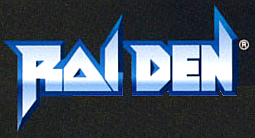Raiden (game series)
| Raiden | |
|---|---|
| developer |
Seibu Kaihatsu (1990–1998) Moss LTD (2005–2019) Bandai Namco Studios (2021-) |
| Publisher |
Seibu Kaihatsu (1990–1998) Moss LTD (2005–2019) Bandai Namco Entertainment (2021-) |
| First title | Raiden (1990) |
| Last title | Raiden V (2016) |
| Platform (s) | Arcade , MS-DOS , Jaguar , Lynx , PC Engine , PlayStation , PlayStation 2 , PlayStation 4 , SNES , Windows , Xbox 360 , Xbox One |
| Genre (s) | Shoot 'em up |
Raiden ( Japanese : 雷電 , German for "lightning and thunder") is a video game series by the Japanese manufacturer Seibu Kaihatsu . The games belong to the genre of vertically scrolling shoot 'em ups and were originally published for arcade machines of the JAMMA format, but have also been ported to other systems in many cases.
All parts of the series have a cooperative multiplayer mode for two players.
Game description
From the top view, the player controls his aircraft over the landscapes scrolling past from top to bottom and has to destroy enemy flying objects and ground targets of all sizes and shapes. Special enemies leave powerups that upgrade the player's weapons. At the end of each level, the player must defeat the final boss . The surcharge is then calculated on the player's points account. If the player uses up all his lives , the game is over. However, the player may be a Continue to use to continue at the point of failure, so his score is reset, however.
As a graphic set, Raiden uses an earth-like landscape with science fiction vehicles and airplanes. All graphics are shown as bitmaps . Due to the representation of a more realistic landscape instead of space scenarios from early shoot 'em ups, Raiden is also occasionally counted as a sub-genre of landscape shooters.
Special features of the game are the extremely brutal explosions and the falling opponents (Raiden II) that crash on earth. The spaceship's choice of weapons is also innovative. The powerups are constantly changing their color. Only one active weapon of the color currently appearing on the power-up is upgraded. If the player has another weapon active than the one of the color just shown, the weapon of the displayed color is switched to without an upgrade. The various weapon "colors" differ considerably from one another. As a choice between a weak but widespread machine gun or a strong but spatially limited laser gun .
Secondary weapon systems are also available. The upgrade process for missiles is the same as for primary weapons, with the player having the choice between guided and unguided missiles. The game also has the genre- typical Smartbombs , which are limited in number. Unused Smartbombs are credited to the player as a bonus at the end of the level. In addition, the player can collect hidden medals in the levels , which at the end also result in random points. A running gag is the fairy hidden in various levels , through which the player receives a direct bonus.
Parts of the series
Raiden (1990)
The first part appeared in 1990 and was implemented for PC Engine , MS-DOS , Super Nintendo (as Raiden Trad ), PlayStation (with Raiden II as The Raiden Project ), Atari Lynx and Jaguar . For the PC engine system, a version entitled Super Raiden appeared in 1992 .
The game's weapon selection included two primary weapon systems (red and blue) and two different types of missiles by default.
Raiden II (1993)
The second part was implemented for MS-DOS and PlayStation (with the original game as The Raiden Project ).
The game featured much more detailed graphics, e.g. Partly reminded of the works of the Bitmap Brothers . It added a third primary weapon (in pink) and a second type of Smartbomb ( cluster bomb ) to the game.
Raiden DX (1994)
Raiden DX is only a slightly modified version of the second part, which was also implemented for PSX . The changes included new graphics and sounds as well as the ability to choose different sequences of levels.
Raiden III (2005)
The third part appeared twelve years after the second and was implemented for Arcade and the PlayStation 2 . There is also an implementation for Windows . Raiden III was developed by Moss LTD under license from Seibu Kaihatsu.
The game seamlessly builds on its predecessor, but couldn't convince all fans of the older Seibu-Kaihatsu series without reservation by switching to the newer polygon graphics.
In particular, the particle effects are clearly weaker in Raiden III despite the newer graphics engine, the target-seeking plasma shot in Raiden III lost a lot of its mobility and is hardly distracted, and the fragmentation bombs from earlier parts are completely eliminated here.
Raiden IV (2007)
Raiden IV was released in 2007 for Arcade and the Xbox 360 .
Raiden V (2016)
Raiden V was released for Xbox One in 2016 .
Raiden V: Director's Cut (2017)
Raiden V: Director's Cut was released in 2017 for the PlayStation 4 and Windows .
Raiden VI (TBA)
Spin-offs
Outside of the Raiden series, various spin-offs were only released as arcade versions . These were the Raiden Fighters series as well as the Viper Phase 1, which is identical in terms of the engine . Overall, the titles are presented as follows:
- Viper Phase 1 (1995)
- Raiden Fighters (1996)
- Raiden Fighters 2: Operation Helldive (1997)
- Raiden Fighters Jet (1998)

